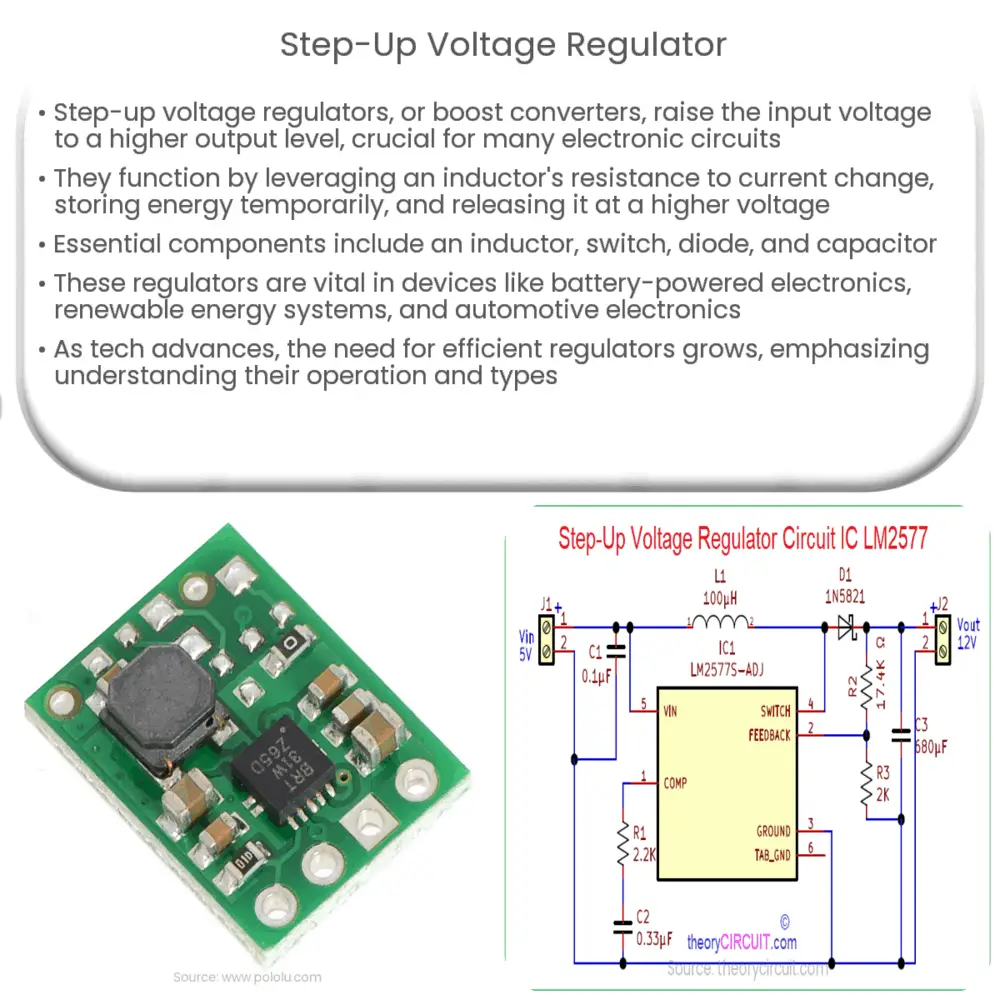Explore the role, working principle, components, types, and applications of step-up voltage regulators in this comprehensive guide.

Introduction to Step-Up Voltage Regulators
A step-up voltage regulator, also known as a boost converter, is an electronic device designed to increase the input voltage to a higher output voltage. These regulators are of significant importance in many electronic circuits and devices where a higher voltage level is required than the one available from the power source.
Working Principle of Step-Up Voltage Regulators
The core functionality of a step-up voltage regulator is based on the principle of inductor’s property to resist changes in current flow, resulting in an increase in voltage level. It works by temporarily storing energy in an inductor and then releasing it to the load at a higher voltage.
Main Components of a Step-Up Voltage Regulator
- Inductor (L): This is the key component that allows the boost converter to increase the voltage. When current flows through the inductor, it stores energy in the form of a magnetic field. When the current is reduced, the stored energy is released, which results in an increased voltage.
- Switch (S): The switch is used to control the current flow through the inductor. When the switch is closed, current flows through the inductor and energy is stored. When the switch is opened, the current path is broken and the stored energy is released.
- Diode (D): The diode ensures that current flows in the right direction, preventing it from flowing back to the source when the switch is open.
- Capacitor (C): The capacitor smoothens the output voltage, filtering out any ripple resulting from the switching operation of the inductor.
Applications of Step-Up Voltage Regulators
Step-up voltage regulators are widely used in various electronic devices and systems. These include:
- Battery-Powered Devices: Devices that operate on batteries often require higher voltages than what the battery can supply. For instance, a device operating on a 3V battery might need 5V for certain components. In this case, a step-up voltage regulator would be used to boost the voltage.
- Renewable Energy Systems: Renewable energy systems, like solar or wind power systems, often generate power at a lower voltage level. To feed this power into the grid or to use it for appliances that require higher voltage, a step-up voltage regulator is used.
- Automotive Systems: In automotive electronics, step-up voltage regulators are used to power high-voltage systems from a lower-voltage battery.
Types of Step-Up Voltage Regulators
There are various types of step-up voltage regulators, each with unique characteristics and advantages. These include:
- Non-Isolated Boost Converters: These are the simplest form of step-up voltage regulators. They are inexpensive and compact, but do not provide isolation between the input and output.
- Isolated Boost Converters: These provide electrical isolation between the input and output, which can be essential for safety and noise reduction in certain applications. However, they are typically more complex and expensive.
- Synchronous Boost Converters: These use two switches instead of a switch and a diode, improving efficiency. However, they are more complex and require careful control to prevent short circuits.
Choosing the Right Step-Up Voltage Regulator
Selecting the right step-up voltage regulator requires consideration of several factors. These include the input and output voltage requirements, the power level, the efficiency, and the need for electrical isolation. It’s also important to consider the size, cost, and complexity of the regulator. Professional guidance or deep understanding of the specific requirements of the application is often necessary to make the best choice.
Conclusion
In conclusion, step-up voltage regulators are an essential component in the field of electronics, playing a crucial role in a wide range of devices and applications. Their ability to increase voltage levels allows for greater flexibility in the design and operation of electronic systems. As technology continues to advance, the demand for more efficient and compact step-up voltage regulators is likely to increase. Therefore, understanding their working principle, components, types, and applications is of paramount importance for anyone involved in the design, implementation, or use of electronic devices and systems.

